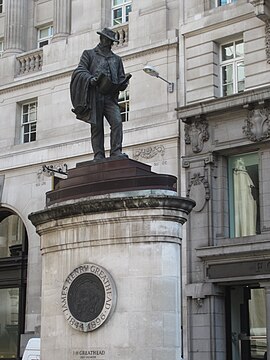
The Waterloo & City line, colloquially known as The Drain, is a London Underground shuttle line that runs between Waterloo and Bank with no intermediate stops. Its primary traffic consists of commuters from south-west London, Surrey and Hampshire arriving at Waterloo main line station and travelling forward to the City of London financial district, and for this reason the line, except in very limited circumstances, does not operate on Sundays or public holidays. It is one of only two lines on the Underground network to run completely underground, the other being the Victoria line.

Bank and Monument are interlinked London Underground and Docklands Light Railway (DLR) stations that form a public transport complex spanning the length of King William Street in the City of London. Bank station, named after the Bank of England, opened in 1900 at Bank junction and is served by the Central, Northern and Waterloo & City lines, and the DLR. Monument station, named after the Monument to the Great Fire of London, opened in 1884 and is served by the District and Circle lines. The stations have been linked as an interchange since 1933.

A tunnelling shield is a protective structure used during the excavation of large, man-made tunnels. When excavating through ground that is soft, liquid, or otherwise unstable, there is a potential health and safety hazard to workers and the project itself from falling materials or a cave-in. A tunnelling shield can be used as a temporary support structure. It is usually in place for the short-term from when the tunnel section is excavated until it can be lined with a permanent support structure. The permanent structure may be made up of, depending on the period, bricks, concrete, cast iron, or steel. Although modern shields are commonly cylindrical, the first "shield", designed by Marc Isambard Brunel, was actually a large, rectangular, scaffold-like iron structure with three levels and twelve sections per level, with a solid load-bearing top surface. The structure protected the men from cave-ins as they laboured within it, digging the tunnel out in front of the shield.
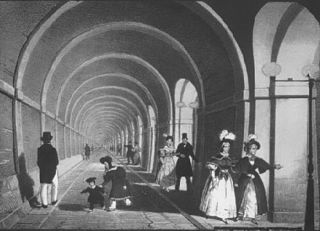
The Thames Tunnel is a tunnel beneath the River Thames in London, connecting Rotherhithe and Wapping. It measures 35 feet (11 m) wide by 20 feet (6 m) high and is 1,300 feet (396 m) long, running at a depth of 75 feet (23 m) below the river surface measured at high tide. It is the first tunnel known to have been constructed successfully underneath a navigable river and was built between 1825 and 1843 by Marc Brunel and his son Isambard using the tunnelling shield newly invented by the elder Brunel and Thomas Cochrane.

The Rotherhithe Tunnel, designated the A101, is a road tunnel under the River Thames in East London, connecting Limehouse in the London Borough of Tower Hamlets north of the river to Rotherhithe in the London Borough of Southwark south of the river. It was formally opened in 1908 by George, Prince of Wales, and Richard Robinson, Chairman of the London County Council. It is a rare example of a road tunnel where road traffic, pedestrians and cyclists all share the same tunnel bore. Transport for London took over ownership and maintenance of the tunnel in 2001.

James Henry Greathead was a mechanical and civil engineer renowned for his work on the London Underground railways, Winchester Cathedral, and Liverpool overhead railway, as well as being one of the earliest proponents of the English Channel, Irish Sea and Bristol Channel tunnels. His invention is also the reason that the London Underground is colloquially named the "Tube".

The Tower Subway is a tunnel beneath the River Thames in central London, between Tower Hill on the north bank of the river and Vine Lane on the south. In 1869 a 1,340-foot-long (410 m) circular tunnel was dug through the London clay using a cast iron shield, an idea that had been patented in 1864 by Peter W. Barlow but never built.
Peter William Barlow was an English civil engineer, particularly associated with railways, bridges, the design of tunnels and the development of tunnelling techniques. In 1864 he patented a design for a cylindrical tunnelling shield, and obtained a provisional patent in 1868 for an improved design.

Totley Tunnel is a 6,230-yard tunnel under Totley Moor, on the Hope Valley line between Totley on the outskirts of Sheffield and Grindleford in Derbyshire, England.
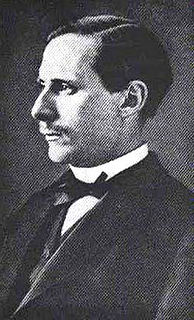
Alfred Ely Beach was an American inventor, publisher, and patent lawyer, born in Springfield, Massachusetts. He is most known for his design of New York City's earliest subway predecessor, the Beach Pneumatic Transit. He also patented a typewriter for the blind.

The City and South London Railway (C&SLR) was the first successful deep-level underground "tube" railway in the world, and the first major railway to use electric traction. The railway was originally intended for cable-hauled trains, but owing to the bankruptcy of the cable contractor during construction, a system of electric traction using electric locomotives—an experimental technology at the time—was chosen instead.

The Abraham Lincoln commemorative plaque is a work of public art designed by Marie Stewart in 1906, created by Rudolph Schwarz, and dedicated on 12 February 1907.

Bank Junction is a major road junction in the City of London, the historic and financial centre of London, at which nine streets converge and where traffic is controlled by traffic lights and give-way lines. It is named after the nearby Bank of England. Directly underneath it is one of the ticket halls of Bank station, one of the busiest stations on the London Underground.

The Guards Memorial, also known as the Guards Division War Memorial, is an outdoor war memorial located on the west side of Horse Guards Road, opposite Horse Guards Parade in London, United Kingdom. It commemorates the war dead from the Guards Division and related units during the First World War, and of the Household Division in the Second World War and other conflicts since 1918.
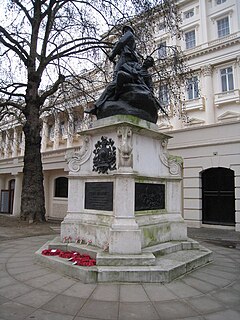
The Royal Marines Memorial, also known as the Graspan Royal Marines Memorial, is an outdoor bronze sculpture by Adrian Jones, installed on the north side of The Mall in London, United Kingdom. Located next to Admiralty Arch, the 1903 memorial commemorates the Royal Marines who died in the Boxer Rebellion in China and the Second Boer War in Africa, and depicts two figures on a Portland stone plinth.

The London Troops War Memorial, located in front of the Royal Exchange in the City of London, commemorates the men of London who fought in World War I and World War II.

The Cavalry of the Empire Memorial, also known as the Cavalry Memorial, is a war memorial in Hyde Park, London. It commemorates the service of cavalry regiments in the First and Second World Wars. It became a Grade II listed building in 1987, and was promoted to Grade II* in November 2014.
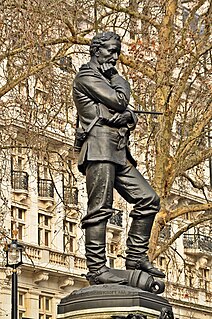
A bronze statue of General Charles George Gordon by Hamo Thornycroft stands on a stone plinth in the Victoria Embankment Gardens in London. It has been Grade II listed since 1970. A similar statue stands at Gordon Reserve, near Parliament House in Melbourne, Australia, on its original tall plinth.

Kingston upon Thames War Memorial, in the Memorial Garden on Union Street, Kingston upon Thames, London, commemorates the men of the town who died in the First World War. After 1945, the memorial was updated to recognise casualties from the Second World War. The memorial was commissioned by the town council and was designed by the British sculptor Richard Reginald Goulden. The memorial includes a bronze statue of a nude warrior, carrying a flaming cross and wielding a sword with which he defends two children from a serpent, erected on a granite plinth, with bronze plaques listing the names of the dead. Goulden designed a number of such allegorical memorials, including others at Crompton, Greater Manchester, and Redhill, Surrey. The Kingston memorial was designated a Grade II listed structure in 1983. This was revised upwards in 2016 to Grade II*, denoting a building or structure of particular importance.

The Confederate Memorial, was installed in Jacksonville, Florida's Hemming Park, in the United States. The monument was removed in June 2020.
